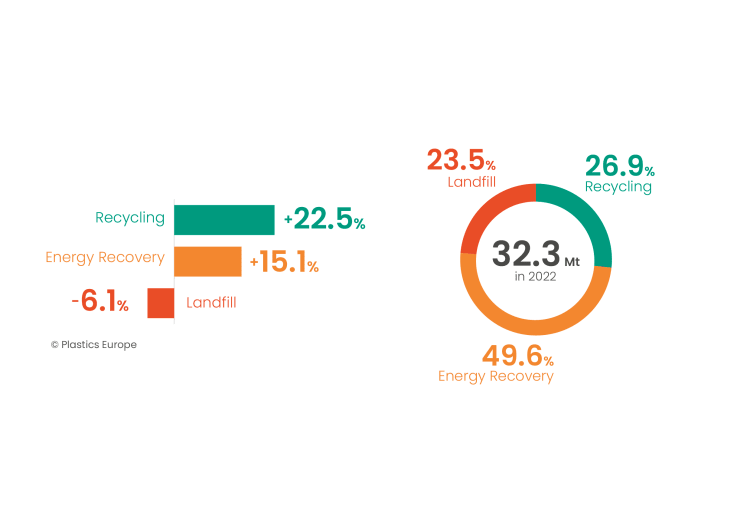
Challenges still remain
While many of the indicators show general progress towards circularity, the report also points to a number of challenges that require particular attention. For example, incineration with energy recovery increased by more than 15 per cent from 2018 (to 16 million tonnes in 2022), and approximately 25 per cent of plastic waste is still sent to landfill (7.6 million tonnes in 2022), even though a considerable portion of such waste could be recycled. The authors of the report emphasise that unless urgent steps are taken to increase the availability of circular feedstock, it will not be possible to sustain the current rate of progress and meet either European-level or industry-level circularity targets.
One of the challenges identified in the report is the growing competitiveness gap between Europe and the rest of the world. According to the authors, “Europe’s share of global plastics production decreased from 22% in 2006 (53,9 Mt) - when Plastics Europe began tracking global production data - to 14% in 2022 (58,8 Mt), with China, North America and the Middle East accounting for 32%, 17%, and 9% respectively.” As a result, Europe is becoming “increasingly dependent on imports which do not necessarily meet EU sustainability standards,” and the ability of European plastics producers (as well as many sectors that rely on plastics) to invest in circularity may be undermined. Hence, restoring the competitiveness of the European plastics sector is becoming vital to the EU’s economy.
Circular plastics in Poland
According to the available data, 2,365,000 tonnes of plastics were produced in 2022 in Poland, including 69.3 per cent from fossil-based feedstock, 19.2 per cent from post-consumer recycled plastics and 11.5 per cent from pre-consumer recycled plastics. Polish converters used 3,896,000 tonnes of plastics, of which 83.6 per cent came from fossil-based feedstock, 10 per cent from post-consumer recycled plastics, 6.2 per cent from pre-consumer recycled plastics and 0.2 per cent from bio-based feedstock. Overall, circular feedstock accounted for 10.2 per cent of all feedstock in new plastic products and components in Poland in 2022.
The recycling rate was 21.2 per cent, corresponding to 452,000 tonnes of plastic waste being recycled. While still below the European average, these figures point to a gradual improvement as the recycling rate grew 8.7 per cent compared to 2018. In line with the overall European trend, agriculture, building/construction and packaging are leading the market when it comes to the use of recycled plastics in Poland.

More to be done in the end-of-life phase
The report shows that the share of post-consumer plastic waste collected separately in Europe is, for the first time, slightly higher than the share of waste from mixed collection streams and stands at 50.7 per cent (16.4 million tonnes). In Poland, however, most plastic waste is still disposed of as part of mixed waste rather than through separate collection, the latter having a share of 43.1 per cent. This is a negative development that requires decisive remedial action, especially considering the fact that the recycling rate for separately collected plastic waste in Poland is as much as 15 times higher than for waste from mixed streams.
Too much waste is still being sent to incineration and landfill despite the adverse environmental impact of these processes and the loss of valuable material. While the share of incineration with energy recovery in Europe has increased by 15% since 2018, Poland has seen even more impressive growth at 24% in comparison with 2018. At the same time, landfilling of post-consumer plastic waste has been decreasing steadily (–6% since 2018). While this is a favourable trend, the report emphasises that the share of plastic waste sent to landfill is still too high (in 2022, the figures stood at 25 per cent for Europe and 43,6% for Poland). What is more, the trend is moving in the wrong direction as the quantity of post-consumer waste sent to landfill has in fact increased since 2016. Another unfavourable trend concerns separately collected waste, 11 per cent of which was still landfilled in Europe in 2022 despite the fact that the Landfill Directive imposes a ban on the landfilling of separately collected waste by 2030. In Poland, the share is even higher at 26%.




